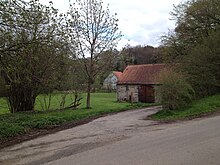Schützeberger Hof
The Schützeberger Hof near Wolfhagen in the north Hessian district of Kassel is a former paper mill founded in the 17th century and operated until after 1830 ; Since the end of paper production, the farm has been run as a farm.
Geographical location
The property is located on the north bank of the Erpe , at the foot of the Mühlenberg, about 2.5 km northeast of the core town of Wolfhagen. The country road L 3214 ( "Sagittarius Straße") from Wolfhagen to Nothfelden and the section Wolfhagen-Altenhasungen the railway Volkmarsen-Vellmar-Obervellmar with the railway viaduct Erpetalbrücke run west of the courtyard of Altenhasungen coming in the East L 3390 north. There are two fish ponds on the south bank of the Erpe opposite the farm. The “Neue Mühle” is located about 300 m downstream at the foot of the Schützeberg .
history
In 1619, the then owner of Elmarshausen Castle , one of the gentlemen from Malsburg , called the paper maker Matthias Schuerman from Lemgo to Elmarshausen . To the northwest of the castle on the right bank of the Erpe , roughly where the Lindengrund meets the Erpe, he converted a grinding mill, attested since 1236, into a paper mill . His sons continued to run the Elmarshausen paper mill and opened other businesses in the near and far.
One of them, Michael Schuermann (1612–1672), initially also worked in Elmarshausen, but then went into business for himself and founded the paper mill below the Mühlenberg in 1670, not far below the confluence of the Lohbach in the Erpe. This mill, too, was initially a flour mill, but was converted into a paper mill with two new aisles . The paper mill was run by his descendants until the 19th century. The raw material used was large quantities of leftover textiles that were delivered by rag collectors from the surrounding area and that were shredded by the water-powered ramming mill and then shredded after fermentation. When machine-made paper made of wood became cheaper in the 19th century, the paper mill became unprofitable and after 1830 it was converted into a farm. In 1978 the mill house was dismantled; one day it will be set up again in the Hessenpark open-air museum in Neu-Anspach in the Hochtaunus district .
The Elmarshausen paper mill was also unable to compete with the modern paper mills and ceased production around 1851.
The Schürmann and Scheuermann family had the right to bury their deceased in the Schützeberg cemetery. Seven grave slabs artistically designed in the Baroque style and restored in 2018 still bear witness to this wealthy and respected family today.
Footnotes
- ↑ Schuermann's descendants are known to be papermakers in the 17th, 18th and sometimes up to the 19th century in Hofgeismar , Wrexen , Twiste , Elben , Geismar , Bettenhausen , Oberkaufungen , Oberaula and Oberhaun ( [1] ). The family name also appears as Scheurmann, Scheuermann, Scheurman, Schürman and Schürmann ( https://data.cerl.org/thesaurus/cnp02077930 ).
- ↑ Like his wife, he came from Lemgo. It is not known when he came to Elmarshausen; he was declared a papermaker there from 1642 to 1658 and from 1663 to 1672. His earliest mention was made of baptism entries for two of his children in the church register of Oberelsungen in 1642/43 .
- ↑ Today, only the owners of the “Kalkhofsmühle”, “Neue Mühle” and “Schützeberger Hof” homesteads are allowed to be buried there ( Wolfhagen cemetery administration: Zum Friedhof aus dem Schützeberg ).
- ↑ Wolfhager paper mill dynasty: The Scheuermann tombs have been restored , HNA, July 18, 2018
Web links
- https://eco-pfade.de/eco-pfad-kulturgeschichte-wolfhagen/papiermuehle-schuetzeberger-hof/
- https://eco-pfade.de/fileadmin/eco_pfad_wolfhagen/tafeln/Tafel-Wolfhagen-Station-5.pdf
- Mill painting Wolfhagen: The courtyard side of the paper mill in 1978 (painting exhibition on the Internet: " Mill walk from Wolfhagen through the Elbe valley to Fritzlar") Copyright by Heimatmaler / mill painter B. Niebert
- Paper for the king; Old craftsmanship: Schuetzberger paper mill delivered to Sweden , HNA, July 14, 2011
literature
- Gerhard Bätzing: The papermaking family Scheurmann (Schürmann) on the two paper mills near Wolfhagen: a genealogical sketch on the history of the papermaking trade in North Hesse and North Waldeck . Degener Verlag , Hanover 1965
- Darius Lenz: The Scheuermann family: From Wolfhagen to Berlin . Ver Verlag, Karlsruhe 2016, ISBN 3-9447-1821-6
Coordinates: 51 ° 20 ' N , 9 ° 12' E
